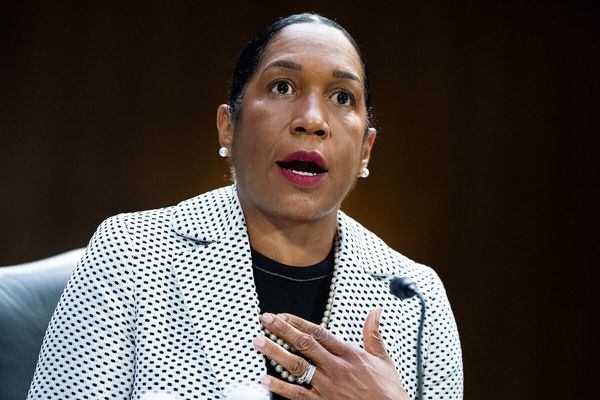/https://static.texastribune.org/media/files/67ab6b983630ceced672cbfea13d18eb/0711%20PUC%20Hearing%20SF%20TT%2006.jpg)
When Hurricane Beryl swept through southeast Texas on July 8, its damaging 80-mile-per-hour winds took down thousands of trees and knocked out much of the electricity system. More than 2.6 million Texas power customers went without electricity for days in the summer heat.
In the days that followed the storm, officials and residents alike turned their eyes to the Houston area’s electric utility, CenterPoint Energy. Texans criticized the company for failing to prepare adequately for the storm, communicate clearly with customers and restore power efficiently.
Gov. Greg Abbott threatened the company, legislators quickly called hearings about the outages and the state’s utility regulators launched an investigation. On July 25, the company's CEO apologized to customers and vowed to improve.
Beryl did between $1.2 billion and $1.3 billion worth of damage to CenterPoint's electricity infrastructure throughout the affected area. Those costs will likely be passed on to customers, who could see a 2% increase on their bills for the next 15 years.
CenterPoint fumbled communications
For days after the storm, CenterPoint did not offer Texans a clear timeline for when power would be restored and its power outage map was offline. That made it difficult for people to decide whether they should wait it out at their homes without air conditioning or head elsewhere. Houstonians turned to a variety of workarounds to figure out which neighborhoods had power — including using Whataburger's app to discern where the electricity was flowing.
When the CenterPoint outage map was back online, people said it was unreliable and couldn't say when they could expect the power to come back on. A week after the storm, hundreds of thousands of customers still had no power.
CenterPoint CEO Jason Wells at a state Senate hearing July 29 said the company was hiring a chief communications officer.
CenterPoint’s restoration pace drew criticism
At the height of the outages more than 2.6 million Texas households and businesses were in the dark. At least 23 people died from the storm itself and the ensuing power outages.
Houston's vulnerability to storms is well known. Unlike a winter storm in 2021 where the energy grid struggled to meet demand, Beryl damaged the distribution infrastructure like poles and wires that bring power to homes.
Ed Hirs, an energy expert at the University of Houston, said the power outages during this storm are a product of extended neglect and underinvestment in grid infrastructure by the state and utilities.
But as people waited in the humid, sweltering heat, they looked for who to blame. Many were angered by the speed in which the company was restoring power. Elected officials began to ask why so much distribution infrastructure was damaged and why it was taking so long to fix.
“In most cases when people lose power it’s because powerlines go down, but it’s normally short lived,” said Joshua Rhodes, a research scientist at the University of Texas at Austin. In this case, he added, the response took days.
CenterPoint defended its readiness and electricity restoration pace, which was faster than it had been after previous storms. But people still wanted answers: Was the utility company prepared for the hurricane? Is it prepared for future ones? And what happened to its communications?
CenterPoint CEO vows to improve communications and protect its infrastructure better
At a July 25 meeting of the Public Utilities Commision, CenterPoint Energy President and CEO Jason Wells apologized to customers and vowed to communicate better and make the system more resilient.
Wells said the company would significantly increase its vegetation management, which includes trimming tree branches near power lines, and launch a new outage tracker by Aug. 1. It will also hire a new senior leader to focus on emergency response coordination.
Company officials said they were already holding small group listening sessions, brought in experts to review its emergency response and nearly doubled their vegetation management workforce. But they said they still face hurdles.
Those challenges include not having direct contact information for more than half of its customers because retail electric companies that sell power to residents and businesses maintain that data. CenterPoint officials said they would need new regulatory policy from the PUC to make it easier to get that information from the retail companies.
At a July 29 Senate committee hearing, Wells said he “made a change” to the head of the company’s electric operations division because he believed CenterPoint needed to move faster on investing in resiliency. But he warned of possible repercussions in improving if he were to answer calls that he step down.
“I think if I resign today, we lose momentum of the things that are going to have the best possible impact for the greater Houston region," he told lawmakers.
CenterPoint officials said in a July 30 call with investors the company had already boosted its spending on vegetation management by 30% in 2023. CenterPoint plans to trim vegetation along 2,000 miles of its lines, particularly in places where that vegetation is at greater risk of causing damage, company officials said.
Reference
Read the report CenterPoint Energy presented to Texas utility regulators on Hurricane Beryl's damage and the company's plans to improve its communications and infrastructure.Didn’t Texas officials say they fixed the power grid?
After Winter Storm Uri in 2021, when nearly statewide power outages persisted for days the entire electricity grid nearly collapsed, lawmakers decided Texas needed more power to meet demand. They focused their efforts on securing power generation, or fuel that is then turned into electricity, through weatherizing existing facilities and allocating $5 billion to incentivize companies to build more gas-fueled power generators in the state.
But Beryl highlighted the need to strengthen the state’s electrical distribution infrastructure, which transmits already generated electricity to individual customers, against future storms and hurricanes. Energy experts said that could include protecting existing power lines from trees by trimming them, building robust poles out of concrete or plastic and undergrounding power lines where it makes sense.
What oversight does Texas have over utility companies?
In Texas, utilities do not compete with each other, but have designated jurisdictions that they serve. The Public Utility Commission of Texas regulates electricity and oversees utilities like CenterPoint. The PUC commissioners are appointed by Gov. Greg Abbott and their job is to review and approve rates charged by utilities, review the planning and construction of utility infrastructure like power lines and coordinate with utilities on how to prepare and respond to hurricanes or other natural disasters.
Essentially any type of infrastructure project or rate increase utilities like CenterPoint proposes needs to be greenlit by the PUC.
The PUC could punish CenterPoint with a fine for its handling of Hurricane Beryl’s outages. But when disasters strike, Ed Hirs, an energy expert at the University of Houston, said regulators typically skip the fine and rely on the expectation that “the cost of the cleanup is going to be more than enough penalty.”
He said regulators often prefer companies spend money repairing damage rather than sending it to the state as a fine. Regulators also could require CenterPoint to put money into strengthening its infrastructure.
In addition to the PUC’s oversight, utilities must also comply with rules and regulations that the Legislature writes into law.
Lawmakers begin discussing ideas for new legislation in wake of large-scale outages
A special panel of 13 Texas senators — many of whom represent areas affected by Hurricane Beryl’s power outages — questioned state energy and emergency officials and the CenterPoint Energy CEO about the company’s planning and response at a July 29 hearing in Austin.
Lt. Gov. Dan Patrick formed the Senate Special Committee on Hurricane and Tropical Storm Preparedness, Recovery, and Electricity after the July outages. At their first meeting, members focused their anger on the Houston-area utility and at times passionately asked about ways it could make changes to prevent such a disaster from repeating.
The senators’ ideas included altering the structure for how utilities in the state’s main power grid — which have no competition and instead earn a profit overseen by the Public Utility Commission of Texas — make money. They also discussed lowering how much profit CenterPoint is able to make.
“I would ask the PUC: Is it time to change the formula to be more outcomes-based?” said Sen. Lois Kolkhorst, R-Brenham.
PUC Chair Thomas Gleeson later agreed: “I think we need a comprehensive look at how we fund utilities, how they prepare for storms,” he said.
Gleeson said the PUC additionally had not succeeded in making sure utilities were doing enough tree trimming.
Senators further suggested clawing back the expense of massive generators that CenterPoint CEO Jason Wells said CenterPoint bought to help in extended power outages after the 2021 winter storm. That storm forced power generators offline and led to calls for widespread power cuts to keep the grid from completely collapsing. The PUC allowed CenterPoint to increase customers’ electricity bills to pay for the generators and earn a profit, according to the Houston Chronicle.
The generators were not used during the hurricane, Wells said. But Wells defended the company’s investment and said CenterPoint had been selling other parts of the business to focus more on its Houston-area operations, especially the transmission system and substations, which Wells said performed well in the storm.
Committee Chair Charles Schwertner, R-Georgetown, said the 2025 legislative session that begins in January could include discussions about those ideas, plus financial penalties, a smaller service territory for CenterPoint, allowing better access for tree trimming and improving standards for infrastructure construction. CenterPoint officials said during a July 30 earnings call that 60% of the vegetation it removed after Beryl came from trees that were outside of their rights-of-way, meaning the company didn't have automatic access to them prior to the storm.
The House State Affairs committee will meet July 31 to discuss utility resiliency plans and assess utility preparedness, response, and recovery protocols given the recent storms.
Public Utility Commission investigating CenterPoint
The PUC is investigating CenterPoint's preparations and response to Hurricane Beryl. The investigation, which was directed by Gov. Greg Abbott, will look into the company's emergency plans, vegetation management like tree trimming, infrastructure fortifications, and use of mobile generators. The aim? To uncover the root causes of persistent power outages in Houston and nearby areas.
The PUC must deliver a report with its findings and recommendations to the governor by Dec. 1.
At a July 25 PUC meeting, company officials outlined changes they planned to make, but PUC commissioners were critical some of those fixes weren't underway before Hurricane Beryl.
“Some of the things that I heard today are things that the company should have already been thinking about doing,” PUC Commissioner Lori Cobos said.
CenterPoint has asked for an extension on its request to raise rates
CenterPoint earlier this year filed an application with the Public Utility Commission of Texas seeking to raise rates to cover costs and keep up with the area’s growth. Utility officials said the average residential bill would increase by about $1.25, according to the company filings.
Utility companies do not make money by doing maintenance like tree trimming or hardening powerlines, but by expanding infrastructure coverage, according to energy experts. But the PUC controls how much money a regulated utility like CenterPoint can make.
To make their case for a rate increase, CenterPoint officials said they now served 300,000 more customers compared to when the company last requested to change its rates in 2019. They expected both population and industrial growth to continue with a shift toward electrification and potential buildout of hydrogen production facilities.
Utility officials said in the filings that they were both expanding the system and keeping up with needed repairs. The company invested more than $6 billion in infrastructure over the past five years while also responding to “unprecedented weather conditions” including drought, winter storms and hurricanes.
“Each event had its impact on the system,” said Lynnae Wilson, senior vice president of electric business. “Drought conditions lead to dead or stressed trees that are more susceptible to high winds. Any system damage as a result of weather events in turn caused customer outages.”
The company said it spent $31.9 million on vegetation management in 2022 and increased its spending on reliability projects.
“CenterPoint Houston faces increasingly high expectations from customers in terms of more reliable service and faster restoration following outages, and from regulators and policymakers increasingly concerned with strengthening the electric grid in Texas,” Jason Ryan, executive vice president of regulatory services and government affairs, said in the March 6 filings.
On July 17, after public outrage over Beryl’s mass power outages, CenterPoint requested more time to keep working through the rate case discussions with the other parties involved. Entities such as the Houston Coalition of Cities, Texas Industrial Energy Consumers and Texas Consumer Association were already weighing in on the proposed rate hike. An administrative judge considering the proposed increase requested that parties file status reports by August 2 and every two weeks after.
Regulators are also reviewing CenterPoint’s $2 billion resiliency plan
Utility companies like CenterPoint can choose to create plans to strengthen their electrical systems, according to a law that went into effect last year.
The so-called resiliency plan — if state regulators approve it — is a potential way utilities could start charging more to harden their distribution infrastructure by replacing poles or trimming more trees. In many cases, those costs would be charged to power providers that sell power, which would then likely pass the costs on to residents and businesses.
Michael Webber, an energy resources professor at the University of Texas at Austin, said spending more up front for a stronger electric system would save money and even protect peoples’ lives and health better over the long term. That’s because there would be less damage to infrastructure after storms — and fewer people without power, too.
In its proposed resiliency plan submitted to regulators in April, Centerpoint suggested investing more than $2 billion to strengthen its poles and wires, using federal and state funding to cover some of the costs. The proposal included spending $376 million to replace wooden transmission structures with steel or concrete, and $99 million to replace or brace some 5,000 wooden distribution poles per year from 2025 to 2027.
Energy experts told The Houston Landing that CenterPoint’s proposed funding for the plan is only a fraction of what’s needed for upgrades to protect the system against bad weather. The Landing also reports that plan does not include details on where upgrades will be made and predictions on how many customers might benefit from proposals to harden the distribution infrastructure.
CenterPoint officials on July 25 said they would amend the plan based on their own review and regulators' review.
Gov. Greg Abbott wants to know CenterPoint’s plans to keep the power on
Gov. Greg Abbott asked CenterPoint to send his office a detailed plan by the end of July outlining how it plans to protect the power supply through the rest of what is expected to be a busy hurricane season.
Abbott said the plan must include better preparation for linemen who repair damage, increasing the number of workers to restore power and how the company will pre-stage sufficient workers to immediately respond to future outages. He also asked the plan to include details on future trimming trees and removing vegetation that threaten power lines — the leading cause of infrastructure damage during Beryl.
If CenterPoint fails to comply with his request, the governor said he will issue an executive order imposing his own requirements on the company, but it’s not clear what those would be or what direct power he has over the utility. And he said that if the utility is unable to “fix its ongoing problems,” the state would have to reconsider the breadth of the territory it serves.
The governor has asked CenterPoint to remove vegetation around power lines no later than Aug. 31.
Disclosure: CenterPoint Energy, University of Texas at Austin and University of Houston have been financial supporters of The Texas Tribune, a nonprofit, nonpartisan news organization that is funded in part by donations from members, foundations and corporate sponsors. Financial supporters play no role in the Tribune's journalism. Find a complete list of them here.







